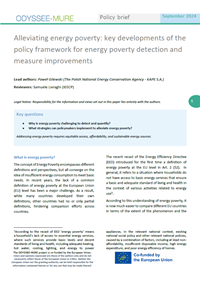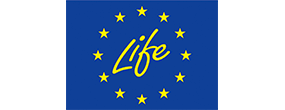Summary
Key questions
- Why is energy poverty challenging to detect and quantify?
- What strategies can policymakers implement to alleviate energy poverty?
Addressing energy poverty requires equitable access, affordability, and sustainable energy sources.
Lead authors: Paweł Gilewski (The Polish National Energy Conservation Agency - KAPE S.A.)
Reviewers: Samuele Livraghi (IEECP)
What is energy poverty?
The concept of Energy Poverty encompasses different definitions and perspectives, but all converge on the idea of insufficient energy consumption to meet basic needs. In recent years, the lack of a common definition of energy poverty at the European Union (EU) level has been a major challenge. As a result, while many countries developed their own definitions, other countries had no or only partial definitions, hindering comparison efforts across countries.
The recent recast of the Energy Efficiency Directive (EED) introduced for the first time a definition of energy poverty at the EU level in Art. 2 (52). In general, it refers to a situation where households do not have access to basic energy services that ensure a basic and adequate standard of living and health in the context of various activities related to energy use1.
According to this understanding of energy poverty, it is now much easier to compare different EU countries in terms of the extent of the phenomenon and the energy improvement measures applied in each to combat it.
Energy poverty initiatives at EU level
The problem of energy poverty was first introduced as a concept in 2009 by Directive 2009/72/EC. Since then, there have been many initiatives to address this phenomenon. These include initiatives such as the Energy Poverty Observatory (EPOV) lunch in 2016 and the Energy Poverty Advisory Hub (EPAH) in 2021, where Member States are expected to address in the National Energy and Climate Plans (NECPs) how they measure and address energy poverty. One of the key elements in the fight against energy poverty was the introduction of the 'Fit for 55' package in 2021. It addresses energy poverty through several key measures, including changes to the EED, the creation of the Social Climate Fund, several initiatives in the building sector, and fair energy transition regulations. More recently, the revised Energy Performance of Buildings Directive has entered into force (May 2024), bringing with it numerous regulations that contribute to the fight against energy poverty.
Detection and quantification challenges
The definition of energy poverty is complex and multifaceted. There are several challenges linked to energy poverty definitions. First, the definition encompasses a wide range of energy services (heating, hot water, cooling, lighting and powering appliances), making it difficult to measure and analyze each aspect comprehensively. Secondly, it emphasizes the ‘relevant national context’, meaning that energy poverty can vary significantly from one country to another, depending on local policies, climate, and economic conditions; this variability makes it difficult to create a universal metric or standard. Third, the definition includes several interrelated factors, such as unaffordability, lack of disposable income, high energy expenditure, and poor energy efficiency. These factors can influence each other, making it difficult to isolate and analyze their individual impacts. Lastly, it mentions the need to take into account existing national social policies and other relevant national policies. This integration requires a deep understanding of different policy areas and how they interact with energy access and affordability. Concepts such as ‘basic needs’ and ‘adequate standard of living and health’ can be subjective and open to interpretation, making it difficult to establish clear, objective criteria for analysis. Collecting accurate and comprehensive data on all these aspects can be difficult, especially in regions with limited resources or infrastructure for data collection.
Europeans struggle with energy poverty
Europe has been struggling with the problem of energy poverty for many years, but the last few years have seen a particularly rapid increase in this phenomenon. In 2023, 10.6% of the European population was classified as energy poor. A year earlier it was 9.3%. In 2021, the level of 6.9% was recorded. There is a clear upward trend. Comparing 2023 with 2021 means an increase of more than 50% in each case. This is certainly not to be underestimated.
Assuming that there are about 741.6 million people living on the European continent, this would mean that 51.4 million people would be affected by energy poverty in 2021 and as many as 78.6 million in 2023. This is only a few million less than the population of Europe's most populous country, Germany.
Another important aspect is the spatial distribution of the phenomenon. As can be seen below (Figure 1), energy poverty is not evenly distributed across EU countries.
Figure 1: Inability to keep home adequately warm by 2022 (% of total population)
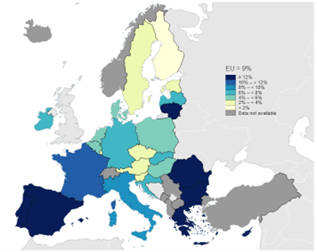
Source: Website: commission.europa.eu based on Eurostat data.
The phenomenon of energy poverty is most prevalent in countries such as Bulgaria, Lithuania, Cyprus and Greece, where figures are above or close to 20%. At the other end of the spectrum are the Nordic countries, as well as the Czech Republic, Austria, and Slovenia, where the phenomenon is practically non-existent. Figure 2 provides detailed values for the countries with the highest shares of energy poverty in the EU.
Figure 2: Countries with highest levels of inability to keep home adequately warm (% of total population)
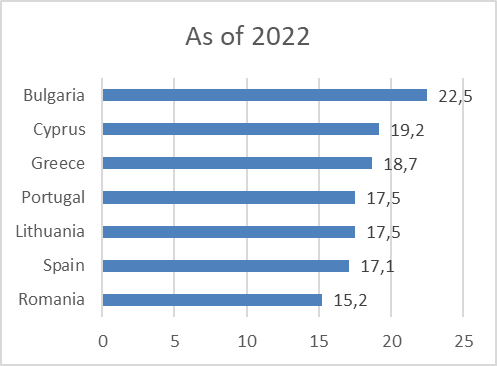
Source: Own elaboration based on Eurostat data.
Energy poverty reflected in the Mure database
A detailed picture of the implementation of energy poverty measures can be found in the Mure database.
First of all, it is worth mentioning how the statistics on the occurrence of measures have evolved in recent years (Table 1).
Table 1: Measures addressing energy poverty in the Mure database
| Year | Aiming mainly or exclusively at energy poverty | Including an important component addressing energy poverty | Total |
| 2021 (July) | 3 | 16 | 19 |
| 2024 (July) | 19 | 56 | 75 |
Source: Own elaboration based on the Mure database.
Over the last three years, the number of measures has increased by as much as 395%. In terms of all Member States, these are not impressive figures, as many countries still have virtually no measures in this area.
Figure 3 shows the measures in the category 'targeting mainly or exclusively energy poverty'.
Figure 3: Division of measures by sector in the category ‘Aiming mainly or exclusively at energy poverty’
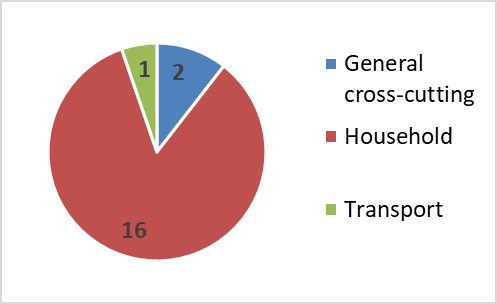
Source: Own elaboration based on the Mure database.
Not surprisingly, measures in the household category dominate the structure. This is due to the fact that energy poverty is thought to be particularly prevalent in this sector, resulting in specific programs to address this phenomenon. The number of measures in the transport sector is still low, despite the fact that energy poverty and the transport sector are closely linked, inter alia in terms of transport costs (e.g. high fuel costs in low-income households can lead to difficulties in covering the costs of commuting to work or school) or accessibility of public transport (forcing people to use alternative forms of transport, which are more expensive and increase their energy expenditure2,3).
The situation is slightly different in the case of the category ‘Including an important component addressing energy poverty’, as shown in the Figure 4.
Figure 4: Division of measures by sector in the category ‘Including an important component addressing energy poverty’
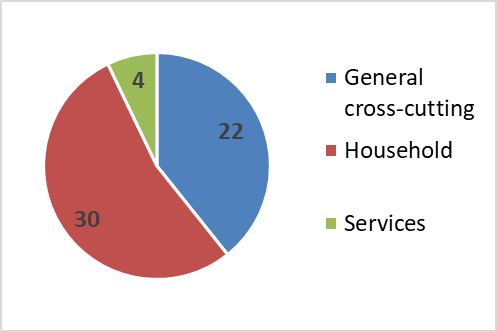
Source: Own elaboration based on the Mure database.
In this case, measures assigned to the ‘Household’ category also dominate, but measures from the ‘General cross-cutting’ category also have a significant share.
This is explained by the very nature of the fight against energy poverty, as many activities are carried out to increase energy efficiency, which indirectly contribute to reducing this phenomenon.
Concluding remarks on the energy poverty
Despite many efforts and actions, the phenomenon of energy poverty continues to grow. Action is being taken at the EU level to address this phenomenon in a comprehensive manner, and the establishment of a formal definition of energy poverty has been an important step in structuring the understanding of this complex phenomenon. Faced with the spectre of further increases in energy prices, this phenomenon may soon accelerate rapidly in some EU countries. Beyond the financial aspects, it will be interesting to further explore the socio-economic impact of energy poverty, as it has significant implications in terms of education, health, and economic opportunities. Another aspect that will be interesting to deepen is community engagement. Involving local communities in energy projects can ensure that they meet their specific needs and circumstances.
Notes
- 1: According to the recast of EED ’energy poverty’ means a household’s lack of access to essential energy services, where such services provide basic levels and decent standards of living and health, including adequate heating, hot water, cooling, lighting, and energy to power appliances, in the relevant national context, existing national social policy and other relevant national policies, caused by a combination of factors, including at least non-affordability, insufficient disposable income, high energy expenditure, and poor energy efficiency of homes.
- 2: Allen, Jeff, and Steven Farber. "Sizing up transport poverty: A national scale accounting of low-income households suffering from inaccessibility in Canada, and what to do about it." Transport policy 74 (2019): 214-223.
- 3: Litman, Todd. Evaluating accessibility for transport planning. Victoria, BC, Canada: Victoria Transport Policy Institute, 2017.
